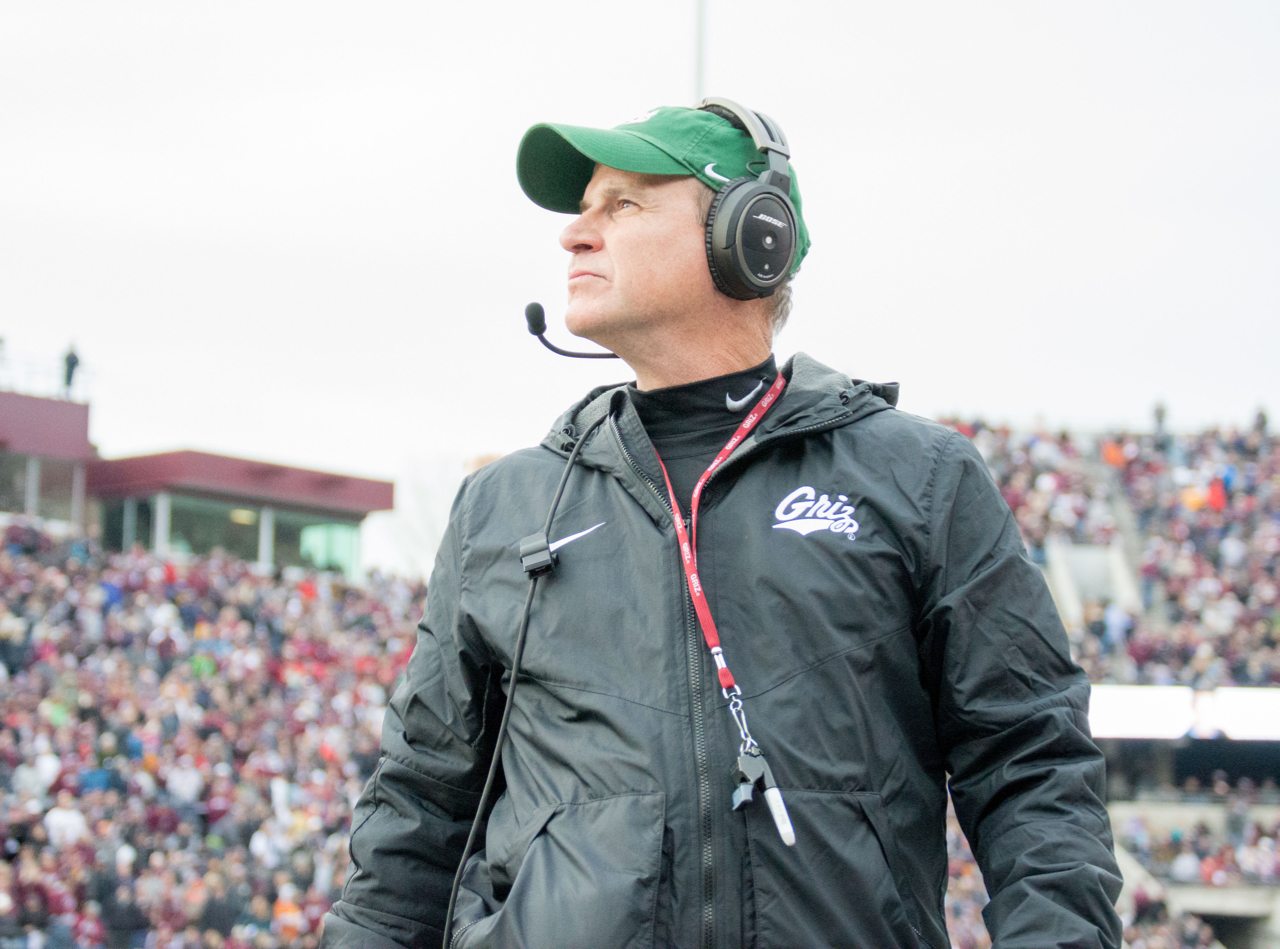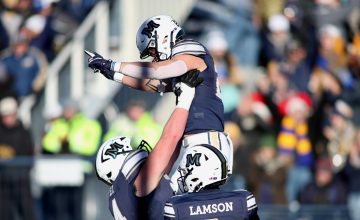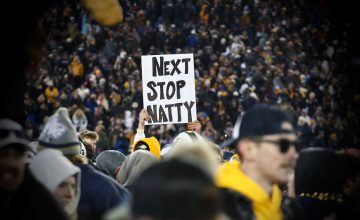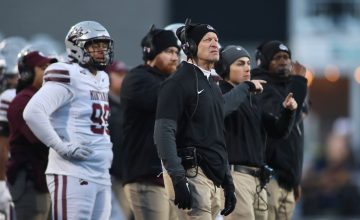The setting at the Adams Center Sky Club following Montana’s 24-17 loss to Montana State felt strange and uncomfortable.
Montana seniors Brady Gustafson and Ryan Johnson and head coach Bob Stitt sat in front of a horde of media eager to probe the reasons why the Grizzlies, with playoffs hopes on the line, lost for the fourth time in five weeks. While the three Grizzlies tried to answer the questions lobbed their way during a 13-minute news conference, echoes of a rollicking party in the depths of the facility drifted up to the Sky Club.
Screams of victory and the pulsating bass of rap music permeated the conference, every now and then interrupting the dialogue between the media and the members of the losing team.
What was happening in the Bobcats’ locker room engaged a mood far more jubilant and energetic that the one Montana’s representatives could produce. Clearly wishing they were somewhere else — probably anywhere else —Gustafson and Johnson reluctantly answered questions. Gustafson, at one point, appeared to cut off a response before the emotions inside boiled over.
For the two players, the loss to the Bobcats marked the end of the line for their collegiate careers. For five years Gustafson and Johnson put in their time, diligently working their way up the team’s depth chart until they were deemed ready to start and play serious snaps.
But that’s over now.
What isn’t over is the examination of an utterly disappointing season that began with the more temperate factions of the Grizzlies’ rabid fan base expecting an 8-3 season, a run at a Big Sky title and a return to the playoffs for the 22nd time since 1993. The more pessimistic, the ones who doubted Stitt and his offense from the day he was introduced as the Grizzlies’ 36th head coach, got about what they expected. At 6-5, the program’s worst record since 2012, Montana will spend Thanksgiving at home with only next season to look forward to.
“It’s hard because it’s the last game and you would like to say that you have to learn from this,” Stitt said. “You’ve got to know this feeling so you never have it again. But for the seniors that doesn’t help.”
To think in mid October that their matchup with the Bobcats would be the Grizzlies’ last game would have been a difficult logical jump to believe. Paired against two clearly overmatched opponents, Montana scored at least 60 points in consecutive games for the first time in program history. During this stretch, they outscored Mississippi Valley State and Sacramento State 128-0 before the Hornets picked up an inconsequential touchdown. At this point, other than superlatives, there was very little else one could scribe about the Griz.
They looked like the teams Bob Stitt wanted them to look like. UM’s second-year head coach talked before the season about returning Montana to Montana. He wanted his teams to resemble those that won 12 straight Big Sky titles, went to five championship games in 10 years, seven in 15 and were consistently mentioned among the FCS elite.
But as four losses in five weeks dropped the Grizzlies down the Big Sky standings, the only mention of the program’s tradition was by those upset with the possibility a 7-4 Montana team might sneak in the backdoor of the playoffs on the strength of its past success.
For Stitt, the losses have been explicable: Against Northern Arizona, he said he didn’t have his team prepared to play in a 45-34 defeat; When Eastern Washington beat the Griz 35-16, the head coach said his team was up for the challenge, but failed to execute in crucial situations; At Northern Colorado, the Griz fell in a 14-0 hole then couldn’t produce enough points in the red zone in a 28-25 loss; and on Saturday, Montana scored on the first play of the game against Montana State then couldn’t keep the ball, running just 20 first-half plays.
“It’s disappointing because we’re not a 6-5 football team,” Stitt said. “We’re a much better football team.”
Whether or not that’s the consensus of the fan base isn’t really what’s important, but it’s likely to be what drives the narrative of the 2016 Montana Grizzlies. And if that is the case, the last two weeks have incensed a great number of people. Losses to Northern Arizona and Eastern Washington could easily be rationalized. Flagstaff is a tough place to play, some say. And Eastern is the No. 2-ranked team in the nation with a win over Washington State, which was tied atop the Pac-12 North as of Saturday night. But the losses to Northern Colorado and the ’Cats completely baffled followers and tripped their deepest fears about their coach.
Against Northern Colorado, a program with 18 prior Big Sky wins since joining the league in 2006, Montana’s offense couldn’t stretch the field. It looked boring and unimaginative and defendable despite moving methodically down the field, finding the red zone on seven occasions. Saturday, the offense finished its last outing of the season with six three-and-outs and an interception against a team that used a very different method to produce a gritty win.
When Jeff Choate, who with his square jaw and imposing demeanor has a look you’d expect of man coaching football in Montana, was hired last December people started to wonder if the new Montana State coach’s workmanlike, defense-first approach was going to be too much for the finesse offense many attributed to Montana. The jury has yet to issue a ruling, but that’s exactly how Montana State won Saturday. It controlled the line of scrimmage rushing for 368 yards and hit Gustafson early when Montana’s offense sputtered through a 20-play first half.
So while the Bobcats celebrated with the Great Divide trophy for the first time since 2012, a win that also came in Washington-Grizzly Stadium, Montana was left wondering what happened. And wondering what is next.
“Adversity is in your life all the time,” Stitt said. “We talk about it. If you can’t handle something like this then you’re really gonna struggle down the road. We talk about facing adversity. It hurts really bad, really bad. You have to bounce back. You have to work harder to make sure you wipe it out.
“We’re tying to build this thing from the ground up. You can’t quick fix something because it will blow up in your face. Years down the line you can’t fix it. We’re going to do it with these young guys.”
Montana is building for the future. Since arriving in December 2014, Stitt and his coaches have overhauled the roster bringing in more than 80 new players. On Saturday, Montana’s first, second, fourth and fifth leading receivers were in the last game of their first year on the field. It’s leading rusher, Jeremy Calhoun, is in his second. The Grizzlies relied on a defensive line with three new starters. There were three new linebackers and two new starters in the secondary. And in the first few rows of the student section stood a handful of players expected to challenge for starting positions when the Griz take the field for spring practice in March 2017.
“We didn’t win enough games this year to make everybody happy,” Stitt said. “But we’re going to because we’re doing it the right way. At some point — you hope it’s sooner than later — everything clicks because everybody is on the same page. You’re dealing with young dudes, you know, young guys. We love them, but they’re young guys. You’ll say, ‘Why would you do something like that?’ And they’ll say, ‘I don’t know, I don’t know.’ And it costs you a football game. You have to keep working with them. You hug them, you parent them, you get on their butts sometimes and you gotta just make sure that they understand that it’s bigger than themselves. Man we’re close because of this guy (Gustafson) and this guy (Johnson) and all of our seniors we are so close.”


















